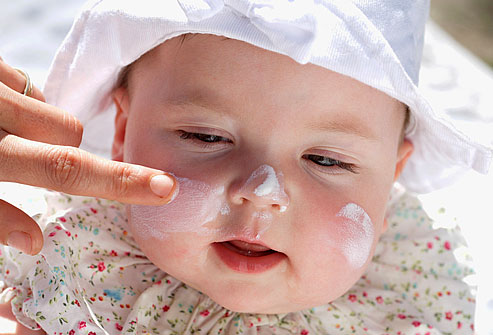

To perform better in the heat, cool down before you warm up. Research shows that lowering your body temperature prior to exercise increases the amount of heat your body can tolerate, which delays fatigue.
The best way: Slowly sip a flavored ice slushie starting 30 minutes before you exercise. Athletes who did this before running on a treadmill in hot room ran an average of 10 minutes longer than those who drank cold, flavored water, according to a 2010 study in the journal Medicine & Science in Sports & Exercise. Because the runners’ bodies had to convert the slushies from ice to water, they may have transferred more heat to the drink rather than store it internally where it would have raised their core temperatures, say researchers.

When University of Missouri-Columbia researchers tested 10 brands of popular athletic socks for blister-causing potential, 100 percent cotton socks fared the worst. That’s because, compared to synthetic fibers, cotton retains more moisture and is more likely to lose its shape, causing friction—factors that can lead to sores.
In this study, nylon socks performed the best. However, any sweat-wicking synthetic blend will perform better than cotton. Your best bet is to go to a running shop or specialty store and buy two or three pairs to try. (Keep in mind: Higher price does not equal higher quality). When you find a brand you like, go back to the store and stock up.
Don’t: Hide your eyes with a hat

Caps and visors only block about 50 percent of vision-damaging UV rays, according to the American Optometric Association, meaning your eyes still get assaulted by radiation bouncing off the road and other surfaces. Short-term exposure can lead to temporary irritation and sensitivity. Even worse, over time, “sunburn of the eye” increases your chances of developing cataracts and macular degeneration.
To protect your peepers, wear wrap-around sunglasses that screen out 75 to 90 percent of visible light and block 99 to 100 percent of both UV-A and UV-B radiation. Unfortunately, UV labeling isn’t standardized. If you have any questions, ask an optometrist; she has equipment that can detect the level of defense.
Do: Get outside

Sure, air conditioning and fans feel great when you’re working up a sweat, but it only takes five minutes of outdoor exercise, such as walking, gardening, or cycling, to boost your mood and self esteem, say University of Essex researchers. Although they aren’t sure why, researchers did note that the effect is greatest near water.
Take a lunchtime stroll around the block or commit to a regular gathering: You can join a sports team at active.com or find hiking, biking, or kayaking groups
Don’t: Skip the sunscreen

This is one essential that should be a part of any outdoor exercise routine: One study found that cyclists are exposed to more than 30 times the upper limit of UV radiation exposure set by the International Commission for Non-Ionizing Radiation Protection, putting them at an increased risk of premature aging and skin cancer.
The Skin Cancer Foundation recommends applying 1 ounce (2 tablespoons) of a broad spectrum, water-resistant or waterproof sunscreen (SPF 15 or higher) to your entire body 30 minutes before going outside—even if it’s cloudy. Reapply every two hours or immediately after swimming or excessive sweating.
Do: Avoid the midday sun

Lacing up your sneakers may not be the smartest thing to do on a hot afternoon. From April to October, the sun’s rays are strongest between 10 am and 4 pm, meaning you’re at a higher risk of UV-induced skin damage and heat-related illnesses, such as cramps, stroke, and exhaustion.
Exercise in the morning or evening—when it’s likely to be cooler—in an area that provides lots of shade, and rest 10 minutes for every hour of work. Remember to check the heat index before heading outdoors; it will give you a more accurate idea of what the temperature feels like. If it’s at or above 90 degrees Fahrenheit, consider staying indoors. Calculate your local heat index
Do: Listen to your body
Even the fittest people are affected by heat. That’s because hot weather stresses your heart and lungs and increases your body temperature. Under normal conditions, your skin, blood vessels, and sweat level adjust to this increase. However, if you’re exposed to extreme temperatures for too long, these natural cooling systems can fail, making you susceptible to cramping or heat exhaustion, according to the Mayo Clinic.
Monitor your heart rate and slow down if your pulse is higher than your target zone or if you experience weakness, headache, dizziness, muscle cramping, nausea, or rapid heartbeat. If you start to feel off, stop exercising and get out of the heat. Drink water and wet or fan your skin. If you don’t feel better within an hour, develop a fever higher than 102 degrees Fahrenheit, or become faint or confused, seek medical.
Do: Hydrate sufficiently

The American College of Sports Medicine recommends warding off dehydration by drinking about 20 ounces of water or a sports drink two hours prior to exercise, and another 10 ounces 20 minutes before your workout. While exercising, drink at least 10 ounces of water (or a sports drink during intense workouts or workouts lasting an hour or longer) every 10 to 20 minutes. Post-exercise swap your sports drink for a beverage that contains carbohydrates and protein, such as chocolate milk. Studies show this can help you recover faster by replenishing your muscles glycogen stores.
Don’t: Break a sweat in black

You may love the way that black tank top minimizes your waist, but it’s not doing a thing for your workout. Dark, clingy clothes can trap heat against the body, causing you to fatigue faster.
Instead, opt for light-colored, loose-fitting clothing that’s made of moisture-wicking materials. The more air that hits your skin, the less your body has to divert oxygen-rich blood away from your muscles to help you stay cool.
Don’t: Expect the same results

At the start of summer, gradually increase the number and length of your outdoor workouts—it can take up to two weeks for your body to get used to the hot weather, according to a study in the Journal of Athletic Training. To make the process painless, drink plenty of fluids (steering clear of caffeinated beverages before workouts) and get adequate sleep.


